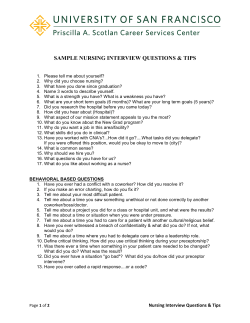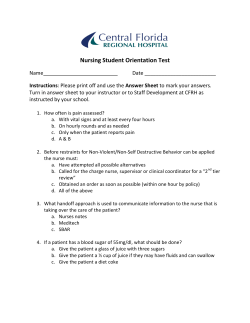
•
THE ROLE OF THE NURSE IN DRUG ADMINISTRATION • Patient’s Rights Because of the risks involved in drug administration patients have the right to: - be informed of the name, purpose, action & potential side effects of drugs - refuse a medication regardless of the consequences THE ROLE OF THE NURSE IN DRUG ADMINISTRATION • Patient’s Rights (con’t) - receive labelled medications safely in accordance with the five (5) rights - be adequately informed of the experimental nature of any drug and sign a written consent - not receive unnecessary medications THE ROLE OF THE NURSE IN DRUG ADMINISTRATION The nurse is also responsible for ensuring that they have the knowledge to ensure the correct administration of drugs. This includes pharmacology, anatomy and physiology, and legal issues. WHAT CONSTITUTES A LEGAL MEDICATION ORDER Medication charts are legal documents and must be completed accurately and unambiguously in order to ensure that patients receive safe and optimal drug therapy. WHAT CONSTITUTES A LEGAL MEDICATION ORDER Medication Charts should be written legibly in the prescriber’s own handwriting and include: Patient’s surname, first name, medical record number (MRN), ward/clinic - if a patient ID label is used it must be affixed to every medication chart and signed for verification by the prescriber WHAT CONSTITUTES A LEGAL MEDICATION ORDER Drug name (generic), dosage form, strength and dose required Complete, clear and unambiguous directions for each item – directions should be written in plain English (only approved abbreviations may be used) WHAT CONSTITUTES A LEGAL MEDICATION ORDER Prescriber’s printed name, signature and date of order - the prescriber’s full signature and date of order must be written for EACH DRUG ordered Weight should be provided for any drug dosed by weight. WHAT CONSTITUTES A LEGAL MEDICATION ORDER N.B. Each medication order must be legible, complete and unambiguous so that the correct patient is administered the correct drug at the appropriate dose. A nurse cannot administer the drug and a pharmacist cannot dispense a drug to a patient unless all details are correct and complete. THE ROLE OF THE NURSE IN DRUG ADMINISTRATION Every registered nurse is legally responsible for the correct administration of drugs. This includes the five “rights” of administration: • • • • • Right Right Right Right Right patient drug dose route time THE ROLE OF THE NURSE IN DRUG ADMINISTRATION • Right Patient – check the patient name & hospital number against the chart & I.D. band. – ask the patient to state his/her name, & their date of birth (D.O.B) THE ROLE OF THE NURSE IN DRUG ADMINISTRATION • Right Drug Identify the drug from the M.O.’s order. Clarify with the M.O. if in doubt. Check the drug three times: - before removing it from the trolley or shelf - when the drug is removed from the container - before the container is returned to storage - check the expiry date of the drug Check the drug with another RN for S4 & S8 drugs THE ROLE OF THE NURSE IN DRUG ADMINISTRATION • Right Dose - check the dose, read the container label, calculate the dose & check with a RN if necessary - use proper measuring devices for liquids, do not crush tablets or open capsules unless directed to by the pharmacist. (do not crush enteric coated tablets). - if a drug is required in another form you may get it from the pharmacy. THE ROLE OF THE NURSE IN DRUG ADMINISTRATION • Right Route - make sure the M.O.’s order is clear & only give the medications by the route designated. - know the abbreviations for the different routes. THE ROLE OF THE NURSE IN DRUG ADMINISTRATION • Right Time - check the time interval ordered by the M.O. & give the medication at the prescribed time. - drugs should be given within 20 minutes of the prescribed time. THE ROLE OF THE NURSE IN DRUG ADMINISTRATION • Allergies Check if your patient: 1. has any known drug allergies 2. has had any previous adverse drug reaction THE ROLE OF THE NURSE IN DRUG ADMINISTRATION Another responsibility of the nurse is to monitor the effect of the drugs that are administered to a client, i.e. - whether the drug had the required effect - little or no effect or - if any adverse reactions occurred. Terms and Definitions • Drug Interactions • The combined effect of two (2) or more drugs • • acting simultaneously. Each drug may have either a positive or negative effect on the working of the others, i.e. they may be antagonistic- lessening the effectiveness of another drug synergistic- enhancing or improving the effectiveness of another drug Terms and Definitions • Adverse Reactions - unwanted and/or unintended effects of the administration of a drug. May be: Iatrogenic Drug sensitivity/allergy Terms and Definitions • Adverse Reactions (con’t) Iatrogenic disease- caused unintentionally by drug therapy, i.e.induced by medical practitioners. Terms and Definitions • Adverse Reactions (con’t) Drug sensitivity/allergy - occurs in an individual who has been previously exposed to the drug and has developed antibodies. Drug allergies can be manifested in a variety of symptoms ranging from minor to serious. Terms and Definitions • Adverse Reactions (con’t) - the reaction can occur immediately after the client received the medication, or be delayed for hours to days. - some of the signs and symptoms are skin rash, urticaria (itching), nausea and vomiting. Terms and Definitions ANAPHYLAXIS A life-threatening immediate reaction is called anaphylaxis. There is respiratory distress, sudden severe bronchospasm, and cardiovascular collapse. It may result in death if not treated immediately. NAMES OF DRUGS Drugs can have three types of names: a. chemical b. generic c. trade/brand/proprietary NAMES OF DRUGS a.Chemical name: - a very precise description of the drug’s chemical composition, identifying the drug’s atomic and molecular structure. - this name is of significance to the pharmacist. NAMES OF DRUGS b.Generic name: - the name assigned by the manufacturer who first develops the drug. Often the generic name is derived from the chemical name. - the official name is the name by which the drug is identified in the official publication. NAMES OF DRUGS c.Trade/ Brand/ Proprietary name: - is selected by the drug company selling the drug and is copyrighted - a drug can have several trade names when produced by different manufacturers NAMES OF DRUGS e.g. Chemical name= Acetylsalicylic acid Generic name = Aspirin Trade names include Aspro, Disprin Be aware that in different countries generic and trade names will also differ, e.g. in Australia & the United States one drug has the generic names of paracetamol & acetaminophen, i.e. Panadol/Tylenol. Categories/Classifications of Drugs Drugs can be classified from different perspectives e.g. drugs may be classified by (a) body systems i.e. drugs affecting the respiratory system drugs affecting the cardiovascular system OR (b) the symptom relieved by the drug, or the clinical indication for the drug i.e. analgesic, antibiotic COMMOM ABBREVIATIONS USED IN MEDICATION ORDERS/frequency • MANE • MIDI • NOCTE • BD • TDS • QID • STAT • PRN • morning • midday • Night • twice a day • three times a day • four times a day • give immediately • when required when necessary COMMOM ABBREVIATIONS USED IN MEDICATION ORDERS/frequency • ac • pc • q.h.or 1/24 • q2h or 2/24 • q4h or 4/24 • before meals • after meals • every hour • every two hours • every four hours COMMOM ABBREVIATIONS USED IN MEDICATION ORDERS/route • BUC • O/P.O • S/L • inside cheek • oral/per oral • sublingal • ID • IM • IMI • • • • SC • (under the tongue) intradermal intramuscular intramuscular injection subcutaneous COMMOM ABBREVIATIONS USED IN MEDICATION ORDERS/route • SCI • subcutaneous • IVI • IVT • • injection intravenous injection intravenous therapy • • • • • • • • nebuliser per rectum topical/skin vaginal NEB PR TOP VAG
© Copyright 2025














